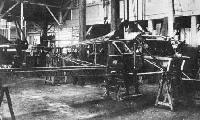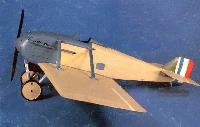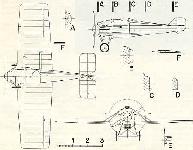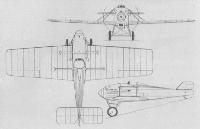J.Davilla, A.Soltan French Aircraft of the First World War (Flying Machines)
Laboratory Eiffel Fighter
The Laboratory Eiffel fighter is listed as being intended to fulfill the C1 fighter category, but the prototype was actually an experimental aircraft intended to test some of the most advanced aerodynamic features that had been developed by 1918. However, it is interesting to compare the C1 specifications with those actually achieved by the Eiffel fighter. The specification called for a maximum speed of 240 km/h, a payload of 220 to 270 kg, a maximum ceiling of 9.000 m, and a service ceiling of 6,500 m.
Gustav Eiffel was a pioneer of aerodynamics and it was the staff of his aerodynamics laboratory who designed and developed the Eiffel fighter. The aircraft was a low-wing monoplane and the wing was almost completely of cantilever design except for two bracing struts on either side of the fuselage. The two parallel wing spars were of duralumin. The fuselage was remarkably streamlined, with the engine and single machine gun completely enclosed. The ventral radiator was located beneath the nose. The elevators and rudder were balanced. Estimated maximum speed for the aircraft was 265 km/h at 4,000 m, with an estimated ceiling of 8,000 m and climb to 4,000 m estimated in 10 minutes.
While the design was strictly the accomplishment of the Laboratory Eiffel staff, led by W. Margoulis, the aircraft was built by the Breguet firm. Hence some sources give its designation as Breguet LE. The initial prototype was fitted with a 180-hp Hispano-Suiza 8Ab engine and the wing structure had been redesigned because of failures in the spars found during static testing. Auxiliary spars were added to carry the ailerons.
Testing began at Villacoublay in March 9 1918 by Jean Saucliere, a fighter pilot on convalescent leave, who made the first flight but damaged the landing gear on takeoff. Alter the aircraft was repaired, Saucliere was allowed, with some reluctance on the part of Louis Breguet, to attempt the second flight alter Breguet's test pilot, Bailliencourt, expressed reservations about flying the LE. The aircraft rose quickly and flew 50 meters before diving into the ground and bursting into flames; Saucliere was killed. The cause for the crash is unknown, but was unofficially attributed to pilot error.
Although tragically brief, this second test flight at least established that the aircraft had an impressive performance, and it was estimated that the maximum speed would be 220 km/h at 4,000 in and that the LE could climb to 4.000 in in ten minutes. These were close to the requirements of the C1 specification.
Based on this estimated performance with only a 180-hp engine, it was planned to re-engine the airframe with a 220-hp Lorraine-Dietrich engine or a 300-hp Hispano-Suiza 8Fb. The airframe for the latter was under construction in January 1918, but apparently the loss of the first prototype resulted in this project being delayed.
At Breguet's insistence, the LE variant with the 220-hp Lorraine-Dietrich was apparently re-designed as a biplane in order to prevent any further structural failures. It was also lightened considerably, possibly also in an attempt to prevent further structural failures.
It seems that the end of the war, coupled with the intense activity at the Breguet plant (which was producing the Breguet 14 and its derivatives), conspired to keep these developments of the Laboratory Eiffel fighter from being completed. The aircraft did leave one lasting impression on French aviation between the wars; because of the catastrophic failure of the Eiffel prototype, further development of the low-wing monoplane was all but abandoned by the French postwar.
LE Experimental Single-Seat Fighter with 180-hp Hispano-Suiza 8Ab
Span 9.78 tn; length 6.35 m; height 2.0 m; wing area 20 sq. m
Empty weight 495 kg, loaded weight 700 kg
Maximum speed (estimated); 220 km/h at 4,000 m; climb to 4,000 m in 10 minutes; endurance 2 hours
No armament was fitted to the LE prototype, but two machine guns were planned for production aircraft
Показать полностью
W.Green, G.Swanborough The Complete Book of Fighters
BREGUET LE France
The Breguet LE (Laboratoire Eiffel) single-seat fighter monoplane was aerodynamically an exceptionally advanced design for its time, emphasis being placed on minimising drag in order to achieve high performance. The basis of the design was produced by the Director of the Laboratoire Eiffel in collaboration with the Breguet design staff, the Breguet company having overall responsibility for translating the basic concept into a prototype. The first prototype LE was fitted with a 180 hp Hispano-Suiza 8Ab eight-cylinder water-cooled engine. Proposed armament consisted of a single 7,7-mm Vickers machine gun totally enclosed within the fuselage, although, in the event, this was never fitted. The LE made a short initial flight at Villacoublay in mid-March 1918, but the undercarriage failed on landing. After repairs, a further flight was made on 28 March, this terminating when the aircraft dived into the ground at full throttle, the pilot, Jean Saucliere, losing his life. Developments of the LE with a 220 hp Lorraine-Dietrich and a 300 hp Hispano-Suiza 8Fb were proposed, and construction of an airframe to take the latter power plant was nearing completion at the time of the loss of the first prototype, when further work was suspended. The following performance data are contemporary estimates for the LE.
Max speed, 137mph (220 km/h) at 13,125 ft (4 000 m).
Time to 13,125 ft (4 000 m), 10 min.
Empty weight, 1,091 lb (495 kg).
Loaded weight, 1,543 lb (700 kg).
Span, 32 ft 1 1/2in (9,78 m).
Length, 20 ft 10 in (6,35 m).
Height, 6 ft 6 3/4 in (2,00 m).
Wing area, 215.28 sq ft (20,0 m2).
Показать полностью
C.Owers French Warplanes of WWI. Volume 1: Fighters (A Centennial Perspective on Great War Airplanes 43)
The Breguet LE - the Laboratorie Eiffel Monoplane
Alexandre Gustave Boenickhausen-Eiffel (1832-1923) is commonly known, if at all, as the creator of the Eiffel Tower in Paris, that was built as a temporary exhibit for the Paris Exposition of 1889. Although steel was displacing iron, Eiffel always worked in iron and so the tower was constructed in iron. After his retirement due to his being involved in the Panama Canal scandal of 1888 he became interested in meteorology and aerodynamics.
He examined the effect of air resistance on various shapes and began by dropping them of the Eiffel Tower with a measuring apparatus attached. He built his laboratory at the foot of the Tower in 1905 and his first wind tunnel there in 1909. Moving to new premises in 1912 he built a larger wind tunnel. He was awarded the Samuel P Langley Medal for Aerodynamics by the US Smithsonian Institute in 1913. His book Resistance de l’Air is a classic and established his reputation as an important contributor to the science of aerodynamics.
After the outbreak of the war Eiffel closed his Laboratory but the Government asked him to reopen it. French manufacturers submitted models of their aircraft for testing, the results being held in secret until after the war when they were published en block as Resume des principaux travaux executes durant la guerre au laboratoire aerodynamique Eiffel entre 1915 et 1918.
It is thought that the design of the Eiffel aeroplane began in the second half of 1916. Models were constructed to test various forms of the fuselage in the wind tunnel. Wing behaviour at different flight regimes, aileron efficiency and stability were measured.
French patent No.503,363 for an avion de chasse a grande vitesse (high speed fighter) was applied for by M. Gustave Eiffel, a resident of France (Seine) on 16 March 1917, and published on 9 June 1920. According to Devaux there were still problems with the many different novel features of the Eiffel monoplane that still had to be worked out when Eiffel submitted his patent. The patent is worth quoting in full:
The present invention relates to an airplane specially designed for the purpose of fulfilling the role of a fighter aircraft; it is established on the following principle:
The resistance of well streamlined bodies is almost entirely due to the friction of the air, that is to say, which is very feeble. However, all the parts of an aircraft can be streamlined, even the wings, especially for these, if one chooses the weight of the aircraft, the power of the motor and the bearing surface, so as to fly at a very low range.
It is also possible to use with relatively thick wings and to insert spars sufficiently solid to remove any bracing which is such a great cause of resistance.
To this end, instead of a biplane cell, one would adopt a monoplane wing, the use of which eliminates all the bracing and allows a greater lift for the same resistance.
There is reason to believe that an aircraft constructed as stated, would achieve speeds superior to those which the present fighter aircraft have reached.
All these arrangements are represented in the accompanying drawing, of which Figs. 1, 2 and 3, are respectively a plan, an elevation and a side view of the aeroplane reduced to a scale of 1/50; in Fig. 4 is a larger scale view of a section of one of the wings.
The aircraft comprises a fuselage a having a rectangular cross-section and a length of about 6 m and a 0.8 m2 torque surface which, according to tests carried out at the Laboratory, have the minimum of resistance. The fuselage a has a 220-hp engine b in front, operating a propeller c rotating at about 2000 rpm, specially adapted according to the tests, in order to achieve at least 76% of the maximum thrust.
The radiator d is composed of several vertical fins through which the water flows. It is placed below the fuselage at the right of the engine and is in contact with the current of air to which it presents only a very low resistance.
The pilot is installed behind the engine and protected by coamings that eliminate almost completely the resistance of his head to the air.
The elevators and rudder g-g are placed at the end of the fuselage. Their control mechanisms are contained inside the fuselage and are not subjected to the resistance of the air.
The machine gun is contained inside the fuselage and fires through the propeller.
The wing, which consists of two symmetrical parts h-h, has together a wingspan of less than 10 m. They are connected directly to the frames that ensure the rigidity of the fuselage. Each of these wings forms a trapezoidal surface of about 10 m with a maximum chord of 2.50 m and a minimum width of 2 m. It is built around two box-shaped spare i, i1, made of duralumin (resistant and extremely light) sheets. The spars have been calculated with a coefficient of safety of 6 calculated on the greatest stresses that the aeroplane can undergo in flight. These two longitudinal members bear the wooden ribs and covered with linen having the profile j, that according to the Laboratory tests, is the most favorable for flight.
The ailerons are carried at the extremities of the wings in order to ensure the transverse stability.
In order to reduce the overhang of the side members, two small struts k of streamlined steel tubes are assembled, which also have the effect of better connecting the wing with the fuselage, and whose air resistance is practically negligible.
The wings are placed at the bottom of the fuselage which makes it possible to give good visibility. This new arrangement for a monoplane is a characteristic of the design.
Thanks to the construction of the wing and the use of duralumin, the weight of the aircraft for flight does not exceed 700 kg, which is a normal weight for aircraft of this type.
The landing gear is formed by an axle carrying two wheels with elastic shock absorption and with the two frames attached to the fuselage.
What constitutes the invention is not such and such a detail, of which analogies would be found in existing aircraft, but in the assembly of the aircraft which presents a new arrangement of attachments with respect to the fuselage and in which air resistance has been reduced to an extent which has not yet been realized, while at the same time employing a relatively large bearing surface, which makes it possible to achieve a high ceiling and low landing speed, while at the same time achieving speeds that are exceptional.
What was remarkable was that the drawings accompanying the patent were for a low-wing monoplane that would have not looked out of place at any 1920 air racing circuit. The patent then described the methods that would be adopted to overcome drag. The motor was stated to be a 220-hp type mounted in the front of the fuselage. Although the type is not stated it is certain that it was meant to be the 220-hp Hispano-Suiza.
Although the patent bears only Eiffel's name, it is considered that Wladimir Margoulis, then head of the Eiffel laboratory, would have contributed to the design, as well as another Russian, Nicolai Zhukovsky.
The wings were semi-cantilevered. Struts ran from the upper longerons to the first compression member of the wing. Conventionally constructed around two parallel spars, the wings had tapered leading and trailing edges. The patent claimed that the design allowed the use of thick spars made up from duralumin. It was natural for Eiffel to consider metal construction for his aircraft. The factory of safety was stated to be 6. While claiming that the design allowed for thick wing sections the aerofoil section illustrated in the patent drawings was a thin high-speed section with sharp leading and trailing edges, convex undersurface and its maximum camber at about 40% of the chord.
The tail surfaces included a balanced rudder but without a fin or fixed tailplane. The new type of radiator, named a lames profondes, was placed under the fuselage between the undercarriage legs.
The wings proved to only have a safety factor of 3. Although the patent had mentioned a factor of 6, the S.T.Ae had adopted 6.5 as the minimum factor for fighters. This led to the wing being redesigned to a factor of 7.5.
The design was presented to Painleve, the Minister of War, on 11 July 1917, and permission to build the machine was granted. Eiffel realised that he did not have the facilities for building an aircraft and asked the Minister to select a manufacturer to build the machine as I do not intend, however, according to the traditions of my laboratory, to derive any personal pecuniary profit from the acceptance of this offer. The construction was given to the Breguet company and was known as the Breguet LE in official files (LE for Laboratorie Eiffel}. The machine that emerged would have been a collaboration between the engineers at the Breguet company under engineer Vullierme, and those from the Laboratorie Eiffel.
The machine was to be delivered by 10 January 1918, with a 220-hp Hispano-Suiza engine for a cost of 20,000 F. Eiffel had chosen, after numerous wind tunnel tests, a wing section that had a biconvex profile with a pointed leading edge.
The airscrew was considered part of the total design in the patent and was designed by the Laboratorie Eiffel. It was manufactured by the Ratmanoff firm. Eiffel ordered three sets of wings from the Societe de Constructions de Levallois which firm manufactured the duralumin spars. Problems were experienced with the large sheets and strips of duralimin that twisted during transportation and storage. The machine's construction was delayed due to the shortage of duralumin and it was not possible to fly the machine in December as proposed.
The monoplane that emerged was very similar to the patent drawings. A direct-drive 180-hp Hispano-Suiza was installed behind a neat spinner, rather than the geared 220-hp version specified in the patent. The undercarriage followed Sopwith design with a half-axle for each wheel that was pivoted at the centre between two spreader bars and rubber shock cord at the simple v-struts. The ailerons were operated by a tube. The hinge of the aileron consisted of a tube extended into the cockpit that was turned in order to move the aileron.
Under the heading "BREGUET" the following report was made by the RFC liaison officer Maj J.P.C. Sewell: -
The interesting EIFFEL machine built by this house was most disappointing in its tests, the wing supports breaking at 3. The output of Breguets owing to the change from Renault to Fiats is also unsatisfactory. One 400 hp Lorraine has been tried in a Breguet AV.
Presumably the "wing supports" refers to the struts connecting the wing to the fuselage. The wings were reinforced and Sewell reported in February that the novel EIFFEL machine which has broken at 3 during its first sand tests has now been reinforced and broken at 7.5 when tested recently. This machine has not yet flown.
The Breguet-Eiffel monoplane was delivered to Villacoublay in March 1918. The machine had a fixed tailplane with plain elevators and rudder. As described in the patent, the operation of these surfaces was concealed inside the machine. Breguet's test pilot Andre de Bailliencourt was tied up with testing the Breguet 14 with the 420-hp Renault engine and a Spad pilot who was convalescing from an illness, Jean Saucliere, agreed to fly the LE monoplane.
Breguet naturally turned to one of his in-house pilots, Andre de Bailliencourt, who initially was involved in setting out the lay-out of the cockpit of the LE with Margoulis and the mechanic Louis Ramondou. When Breguet asked Bailliencourt to make the first flights, Bailliencourt, who was accustomed to heavier planes such as the Breguet XIV, asked to spend some time in a fighter school to familiarize with single-seaters of the Spad or Nieuport type. Bailliencourt was also tied up with testing the Breguet 14 with the 420-hp Renault engine and Breguet turned to other pilots. 27 years old fighter pilot Jean Saucliere, the son of the lyric artist Anne-Marie Saucliere, was recovering from wounds and had been working in the Breguet office as an archivist while recuperating, as was the practice at this period.
Saucliere had been assigned in November 1916 to the Escadrille N79 on Nieuports, where he had won two aerial victories on June 3 and 22 July 1917. The Escadrille reequipped with the Spad VII, then the Spad XIII, becoming Spa 79. Appointed sous-lieutenant on 14 September 14, he was shot down on 11 November and hospitalized with serious injuries. The opportunity to fly was too good to resist and Saucliere accepted the position at a lower salary than the other Breguet in-house pilots. The agreement was simple with a bonus at the end of the first flight.
After fine tuning the engine, the pilot took a seat for a test during the first half of March 1918, which ended quickly. Saucliere had applied full throttle causing the aircraft to take off without achieving flying speed, and it broke the landing gear when it hit the ground.
The plane was repaired and a new test organized in Villacoublay on 27 March. While Ramondou was busy preparing the plane and checking its engine, Saucliere had casually arrived. The young man already announced that on the occasion of his first flight, he intended to visit his Escadrille. Breguet had again asked Bailliencourt to make the first flight, but Bailliencourt repeated his request for additional training. Breguet, probably under time constraints, decided to entrust the prototype again to the young sous-lieutenant.
Sewell's final report on the monoplane stated that the machine, after two or three flights, was crashed and the pilot killed.
On 28 March 1918, the machine had been again ready for testing. After a run past the equipment set up to record its speed, it climbed to about 150 feet and then dived into the ground with the motor full out. It burst into flames killing Saucliere.
What caused the crash was not determined as there was not much left after the fire was extinguished. It may have been the problem with the pilot who could have been in an unfit condition to fly following his illness. What was remarkable was that on this single run the LE showed a higher speed than that estimated for the new Spad with the 300-hp Hispano-Suiza!
An airframe to suit the 300-hp Hispano-Suiza was already in construction in January 1918. A French report for April showed three Eiffel Mono(planes), powered by a 300-hp Hispano, 220-Lorraine and 180M-hp Hispano respectively. The wing area for all three was shown as 20 m2. It appears that the loss of the first machine led to the work being stopped on further examples of the monoplane. According to P Ricco, Breguet had limited confidence in the design and blamed it for the accident. J.M. Bruce notes that Margoulis blamed himself for Saucliere death.
Other proposals were a 220-hp Lorraine-Dietrich powered version of the LE. A report of May 1918 stated that this version was a biplane. This would seem to be against everything that Eiffel had stated in his patent application. A meeting took place towards the end of July between Eiffel, Louis Breguet and Captaine Albert Eteve (the Chef du Service general des avions of the S.T.Ae), at which they were told by Eteve that work was to continue. Breguet agreed on condition that the aircraft was a biplane. This would seem to confirm Breguet's limited confidence in the monoplane design. With all his own development work Breguet did not have the resources available to devote to this project and in the event the biplane never eventuated, a STAe test report of 29 November 1918, noted that the Breguet LE had been abandoned.
Eiffel did not consider his monoplane a failure. In a 1919 publication he stated that the LE had been copied by Junkers, not appreciating the work done by Junkers in determining his aerofoil. In 1920, Eiffel made similar claims that the Junkers-Fokker wing was taken from his LE machine. Eiffel died on 27 December 1923. Although he made a great contribution to aeronautics, he never seemed to accept the loss of the LE monoplane.
Breguet LE Specifications
Source 1 2 3
Dimensions in m
Span 9.78 9.78 9.78
Length 6.35 6.35 6.35
Height - 2.0 2.00
Areas in m2
Wings 20 20 20
Ailerons - - 2.09
Horizontal Tailplane - - 0.84
Rudder - - 1.18
Fin - - 0.15
Rudder - - 0.64
Weights in kg
Empty 495 495 495
Pilot - - 80
Fuel - - 80
Military load - - 40
Accessories - - 5
Total 700 700 700
Performance in km/h
at 2,000 m - - 270
at 4,000 m - 220 269
at ceiling - - 204
Climb to
4,000 m - 10 min -
Endurance in hrs - 8 -
1) J Devaux Data.
2) J. M. Bruce Data.
3) P Ricco. "De l'Avion Eiffel au Leo 9." Avion, France, No. 232, 2019.
Construction of the LE at Breguet
Date Hispano-Suiza 220-hp Lorraine-Dietrich 8 Bd 275-hp Hispano-Suiza 8Fb 300-hp Source
09.11.1917 Being assembled. Expected to be ready 10 December Design only Design study requested by Eiffel. 1
18.12.1917 Assembling, will be ready December. Design only Design study requested by Eiffel. 1
12.1917 200-hp Hispano- Suiza being fitted. In construction. - 2
29.12.1917 In assembly, will be ready by 15 January 1918. - In construction. 1
02 1918 - - In construction. 3
01.05.1918. Crashed. (Engine identified as 180 Hispano). Work suspended. (Identified as biplane with 220 Lorraine) Work suspended. 4
Sources:
1) Monthly Reports on new aircraft.
2) Situation at Breguet Company workshops.
3) Reports on situation with regard to utilisation of new motors.
4) "Department of Aircraft Production, British Ministry of Munitions of War, Paris, Monthly Aeroplane Report. May 1st 1918. French Experimental Aeroplanes, Scouts and Fighters." Chart from TNA AIR1/1071/204/5/1639. RAF Museum, J.M. Bruce Collection Box 15.
Показать полностью





















